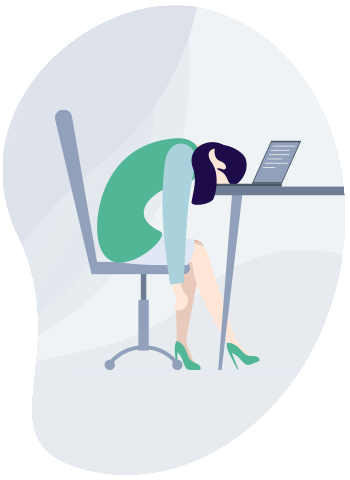As of 2022, the International Classification of Diseases includes occupational burnout. The problem is affecting more and more people. And it doesn’t just apply to Polish workers – the phenomenon affects the global market. What is occupational burnout? How can we avoid this? What can help us with this? What can employers do to take care of employee well-being? We answer!
What is occupational burnout? What are the symptoms?
Occupational burnout according to WHO
According to the WHO (World Health Organization), occupational burnout is classified as an occupational syndrome. Its cause is chronic stress in the workplace, which the employee cannot cope with. Analyzing the phenomenon in more depth, we can learn that occupational burnout is characterized by three dimensions:
- A feeling of energy depletion or general exhaustion,
- Increasing mental distance from one’s own work, a sense of negativism or cynicism about one’s work,
- the emergence of a sense of ineffectiveness, lack of achievement or inadequacy.
However, let’s not confuse occupational burnout with illness. The World Health Organization has not decided to classify occupational burnout as a medical condition or disease entity. It is a syndrome that can affect a worker’s health. What does this mean? For occupational burnout at this point in Poland, we can’t get a medical exemption (L4), due to regulations, more specifically Art. 55(3) item. 9). Law of June 25, 1999.
The origins of the definition of occupational burnout
The concept of job burnout is not as recent as we may think. It was introduced in the 1970s by American psychiatrist Herbert Freudenberger. During his observations on a small group of volunteers, he noticed a certain phenomenon regarding their well-being. It mainly concerned people who were heavily involved in charity work. After a while, they experienced a considerable drop in motivation and initial enthusiasm. These individuals, it turned out, were exhausted by the number of current psychosomatic symptoms they were experiencing.
Symptoms and characteristics of occupational burnout
Occupational burnout is a syndrome of emotional and social traits created due to work-related mental and physical exhaustion and prolonged stress associated with the workplace. It touches everyone, regardless of age, seniority or position and industry. Salesman, programmer, manager, IT recruiter, doctor, teacher or nurse – the rule remains the same. However, occupational burnout most often occurs in people who initially showed high motivation, commitment or invested a lot of energy in their work.
People in public trust professions, such as health care, are particularly predisposed to burnout. Because they involve constant contact with people in need, and this results in overstimulation.
The most common symptoms, by the appearance of which we can suspect professional burnout, are:
- Boredom and discouragement with work, reduced productivity,
- Insomnia, sleep problems,
- Fatigue, depression, mood swings,
- Pessimism, cynicism, apathy,
- Underrated self-esteem, decreased job satisfaction,
- Nervousness, stress, physical fatigue, irritable bowel syndrome.
Causes of professional burnout
Since occupational burnout affects the professional part of life, it can be inferred that the causes of its occurrence will also be found in the work environment. But not only that. The main causes are organizational, personality and interpersonal factors.
Causes of professional burnout:
- chronic stress,
- Too many duties assigned by the supervisor,
- reflux,
- time pressure,
- Failure to maintain work-life balance,
- high expectations,
- too much responsibility,
- sense of lack of control
- insufficient rest.
The emotional exhaustion that accompanies professional burnout is not infrequently caused by a sense of disillusionment and lack of meaning in the work or its mission. Having exorbitant expectations of yourself and your career can also be a cause for increased risk of burnout.
Often, specific traits can contribute to faster job burnout (compared to people who don’t have them, developed to the same level as a burnout person, for example). What are these features? First and foremost: empathy, patience, assertiveness, active and attentive listening or high personal culture.
How to prevent burnout in workplace?
Anti-work burnout as part of wellbeing care and in support of maintaining an appropriate work-life balance should be addressed by both the organization and the employee. What might be the answer to the growing need to take care of these issues?
Above all, the implementation of innovative solutions or reorganization of work culture in the organization will help, such as flattening the structure, moving towards being a turquoise organization, 4-day work week, unlimited vacations, work-life fit, workation, remote or hybrid work, flexible start and end times, free psychological consultations, adjusting the motivation system to employees’ expectations. And much more. Each entrepreneur or company can come up with its own ways to counteract, help in preventing burnout. We are limited here only by our creativity.
The basic activities that everyone should implement in their lives are to try to balance life and work, to distance themselves, to have additional interests outside of work and the time they devote to them. And these are just the basic things.
What can you do as an employee to prevent job burnout?
- Don’t take on tasks that you are unable to complete due to lack of time or skills
- set boundaries
- be aware of your capabilities
- nurture self-development
- Be assertive (learn to say “no”)
- observe the signals sent by your body and your body
- allow yourself to relax
If nothing helps, you should think about changing your job, industry or position.
Send your resume to our database – we will get back to you with a job offer tailored to your expectations.

